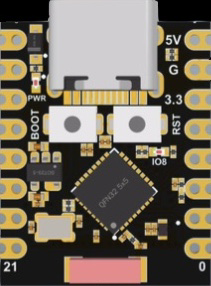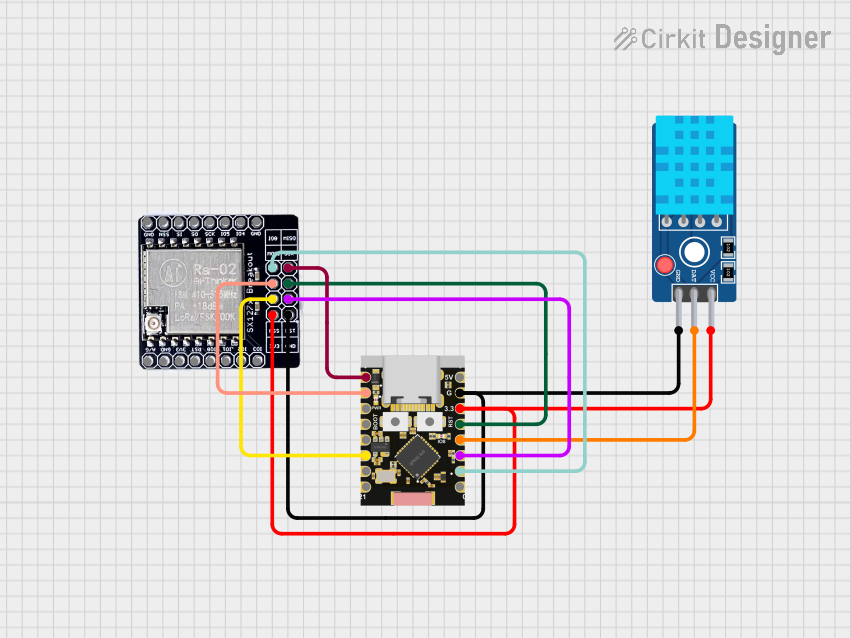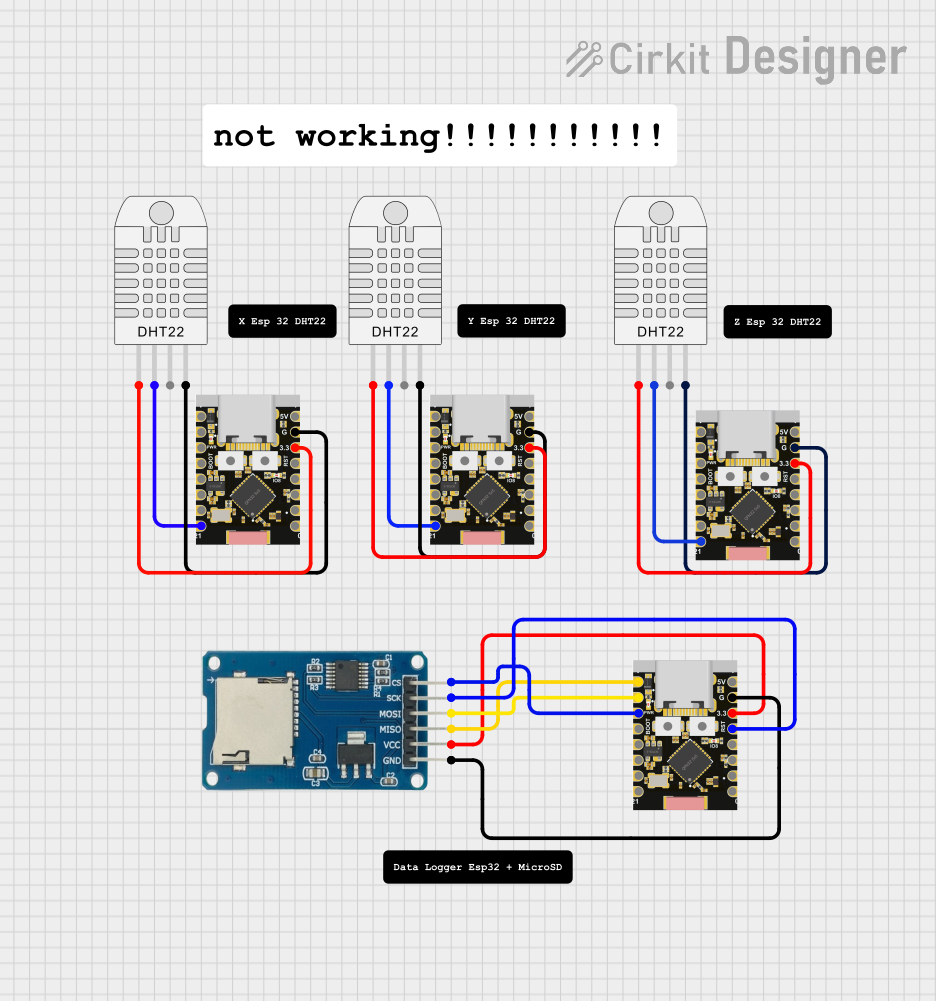
How to Use ESP32-C3 SuperMini: Examples, Pinouts, and Specs

 Design with ESP32-C3 SuperMini in Cirkit Designer
Design with ESP32-C3 SuperMini in Cirkit DesignerIntroduction
The ESP32-C3 SuperMini is a compact, low-power microcontroller developed by Generic. It features integrated Wi-Fi and Bluetooth Low Energy (BLE) capabilities, making it an ideal choice for Internet of Things (IoT) applications. Built on the RISC-V architecture, the ESP32-C3 SuperMini offers efficient performance for a wide range of embedded tasks, including smart home devices, wearables, and industrial automation.
Explore Projects Built with ESP32-C3 SuperMini

 Open Project in Cirkit Designer
Open Project in Cirkit Designer
 Open Project in Cirkit Designer
Open Project in Cirkit Designer
 Open Project in Cirkit Designer
Open Project in Cirkit Designer
 Open Project in Cirkit Designer
Open Project in Cirkit DesignerExplore Projects Built with ESP32-C3 SuperMini

 Open Project in Cirkit Designer
Open Project in Cirkit Designer
 Open Project in Cirkit Designer
Open Project in Cirkit Designer
 Open Project in Cirkit Designer
Open Project in Cirkit Designer
 Open Project in Cirkit Designer
Open Project in Cirkit DesignerCommon Applications and Use Cases
- IoT devices and smart home automation
- Wearable electronics
- Wireless sensor networks
- Industrial monitoring and control systems
- Low-power Bluetooth applications
- Prototyping and development of connected devices
Technical Specifications
The ESP32-C3 SuperMini is designed to deliver robust performance while maintaining a small form factor. Below are its key technical specifications:
General Specifications
| Parameter | Value |
|---|---|
| Architecture | RISC-V 32-bit single-core |
| Clock Speed | Up to 160 MHz |
| Flash Memory | 4 MB (embedded) |
| SRAM | 400 KB |
| Wireless Connectivity | Wi-Fi 802.11 b/g/n, BLE 5.0 |
| Operating Voltage | 3.0V to 3.6V |
| Power Consumption | Ultra-low power in deep sleep mode |
Pin Configuration and Descriptions
The ESP32-C3 SuperMini features a compact pinout with versatile GPIOs. Below is the pin configuration:
| Pin Number | Pin Name | Description |
|---|---|---|
| 1 | GND | Ground |
| 2 | 3V3 | 3.3V Power Supply |
| 3 | EN | Enable pin (active high) |
| 4 | GPIO0 | General-purpose I/O, boot mode selection |
| 5 | GPIO1 | General-purpose I/O |
| 6 | GPIO2 | General-purpose I/O |
| 7 | GPIO3 | General-purpose I/O |
| 8 | GPIO4 | General-purpose I/O |
| 9 | RXD | UART Receive |
| 10 | TXD | UART Transmit |
Usage Instructions
The ESP32-C3 SuperMini is easy to integrate into a variety of projects. Below are the steps and best practices for using this microcontroller.
How to Use the ESP32-C3 SuperMini in a Circuit
- Power Supply: Connect the 3V3 pin to a 3.3V power source and the GND pin to ground.
- Boot Mode: To enter bootloader mode for programming, connect GPIO0 to GND during reset.
- Programming: Use a USB-to-UART adapter to connect the RXD and TXD pins to your computer. Flash firmware using tools like the ESP-IDF or Arduino IDE.
- GPIO Usage: Configure GPIO pins as input or output in your code. Ensure the total current draw does not exceed the pin's maximum rating.
Important Considerations and Best Practices
- Voltage Levels: Ensure all connected peripherals operate at 3.3V logic levels to avoid damage.
- Deep Sleep Mode: Use deep sleep mode to minimize power consumption in battery-powered applications.
- Antenna Placement: For optimal wireless performance, ensure the onboard antenna is not obstructed by metal or other conductive materials.
- Firmware Updates: Regularly update the firmware to benefit from the latest features and security patches.
Example Code for Arduino UNO Integration
Below is an example of how to use the ESP32-C3 SuperMini with the Arduino IDE to blink an LED connected to GPIO2:
// Example: Blink an LED connected to GPIO2 on the ESP32-C3 SuperMini
// Define the GPIO pin for the LED
#define LED_PIN 2
void setup() {
// Initialize the LED pin as an output
pinMode(LED_PIN, OUTPUT);
}
void loop() {
// Turn the LED on
digitalWrite(LED_PIN, HIGH);
delay(1000); // Wait for 1 second
// Turn the LED off
digitalWrite(LED_PIN, LOW);
delay(1000); // Wait for 1 second
}
Troubleshooting and FAQs
Common Issues and Solutions
The ESP32-C3 SuperMini does not power on:
- Ensure the 3V3 pin is connected to a stable 3.3V power source.
- Verify that the EN pin is pulled high.
Unable to upload code:
- Check the USB-to-UART adapter connections (RXD to TXD and TXD to RXD).
- Ensure GPIO0 is connected to GND during reset to enter bootloader mode.
Wi-Fi or Bluetooth not working:
- Verify that the onboard antenna is not obstructed.
- Check the firmware configuration for correct Wi-Fi or BLE settings.
GPIO pins not functioning as expected:
- Confirm that the pins are not being used for other functions (e.g., UART).
- Check for short circuits or incorrect wiring.
FAQs
Q: Can the ESP32-C3 SuperMini operate at 5V?
A: No, the ESP32-C3 SuperMini operates at 3.3V. Connecting it to 5V may damage the device.
Q: How do I reset the ESP32-C3 SuperMini?
A: Pull the EN pin low momentarily to reset the microcontroller.
Q: Is the ESP32-C3 SuperMini compatible with the Arduino IDE?
A: Yes, the ESP32-C3 SuperMini can be programmed using the Arduino IDE with the appropriate ESP32 board package installed.
Q: What is the maximum range of the Wi-Fi and BLE?
A: The range depends on environmental factors, but typically Wi-Fi can reach up to 100 meters in open space, and BLE can reach up to 50 meters.
By following this documentation, users can effectively integrate the ESP32-C3 SuperMini into their projects and troubleshoot common issues.